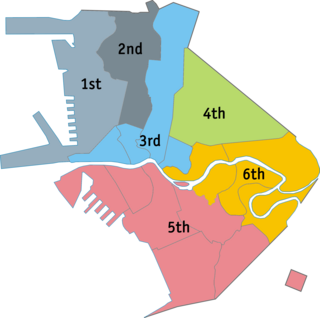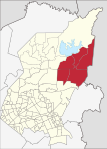
The highly urbanized city of Manila is currently represented in the House of Representatives of the Philippines by its six congressional districts. Every three years, each district elects one representative who will sit on their behalf in Congress. In addition, each district is allotted six seats in the Manila City Council, with councilors being elected every three years.

The legislative districts of Rizal are the representations of the province of Rizal in the various national and local legislatures of the Philippines. At present, the province is represented in the House of Representatives of the Philippines by its four congressional districts, with the districts' representatives being elected every three years. Additionally, each district is allotted a certain number of seats in the Rizal Provincial Board, with board members also being elected every three years.
The legislative district of San Juan–Mandaluyong was the combined representation of the Metropolitan Manila municipalities of Mandaluyong and San Juan in the Regular Batasang Pambansa (1984–1986) and the lower house of the Congress of the Philippines (1987–1995).
The legislative districts of Batangas are the representations of the province of Batangas in the various national and local legislatures of the Philippines. At present, the province is represented in the House of Representatives of the Philippines by its six congressional districts, with the districts' representatives being elected every three years. Additionally, each district is allotted two seats in the Batangas Provincial Board, creating a total of twelve elective seats in the legislature.
The legislative district of Pateros–Taguig is the combined representation of the independent municipality of Pateros and eastern part of the highly urbanized city of Taguig in the Congress of the Philippines. The city and municipality are currently represented in the lower house of the Congress through their lone congressional district.
The legislative districts of Parañaque are the representations of the highly urbanized city of Parañaque in the Congress of the Philippines. The city is currently represented in the lower house of the Congress through its first and second congressional districts.
The legislative districts of Caloocan are the representations of the highly urbanized city of Caloocan in the various national legislatures of the Philippines. The city is currently represented in the lower house of the Congress of the Philippines through its first, second, and third congressional districts.
The legislative districts of Pasay are the representations of the highly urbanized city of Pasay in the Congress of the Philippines. The city is currently represented in the lower house of the Congress through its lone congressional district.

The legislative districts of Bukidnon are the representations of the province of Bukidnon in the various national legislatures of the Philippines. The province is currently represented in the lower house of the Congress of the Philippines through its first, second, third, and fourth congressional districts.

The legislative districts of Cavite are the representations of the province of Cavite in the various national and local legislatures of the Philippines. At present, the province is represented in the House of Representatives of the Philippines by its eight congressional districts, with the districts' representatives being elected every three years. The congressional districts are coextensive with the provincial board districts, where each district is allotted two seats in the Cavite Provincial Board, creating a total of sixteen elective seats in the legislature.
The Legislative district of Las Piñas–Parañaque was the combined representation of the Metropolitan Manila municipalities of Las Piñas and Parañaque in the Regular Batasang Pambansa from 1984 to 1986.
The legislative districts of Davao City are the representations of the highly urbanized city of Davao in the various national legislatures of the Philippines. The city is currently represented in the lower house of the Congress of the Philippines through its first, second, and third congressional districts.
The legislative districts of Zamboanga del Norte are the representations of the province of Zamboanga del Norte in the various national legislatures of the Philippines. The province is currently represented in the lower house of the Congress of the Philippines through its first, second and third congressional districts.

The legislative districts of Bulacan are the representations of the province of Bulacan in the various national legislatures of the Philippines. The province is currently represented in the lower house of the Congress of the Philippines through its first, second, third, fourth, fifth and sixth congressional districts.
The legislative districts of Palawan are the representations of the province of Palawan and the highly urbanized city of Puerto Princesa in the various national legislatures of the Philippines. The province and the city are currently represented in the lower house of the Congress of the Philippines through their first, second, and third congressional districts.

The legislative districts of Laguna are the representations of the province of Laguna in the various national legislatures of the Philippines. The province is currently represented in the lower house of the Congress of the Philippines through its first, second, third, and fourth congressional districts.

The legislative districts of Quezon are the representations of the province of Quezon and the highly urbanized city of Lucena in the various national legislatures of the Philippines. The province and the city are currently represented in the lower house of the Congress of the Philippines through their first, second, third, and fourth congressional districts.
The legislative districts of Taguig are the representations of the highly urbanized city of Taguig in the Congress of the Philippines. The city is currently represented in the lower house of the Congress through its lone congressional district.
The legislative districts of Lapu-Lapu are the representations of the highly urbanized city of Lapu-Lapu in the Congress of the Philippines. The city is currently represented in the lower house of the Congress through its lone congressional district.
The legislative district of Calamba are the representations of the component city of Calamba in the Congress of the Philippines. The city is currently represented in the lower house of the Congress through its lone congressional district.




















